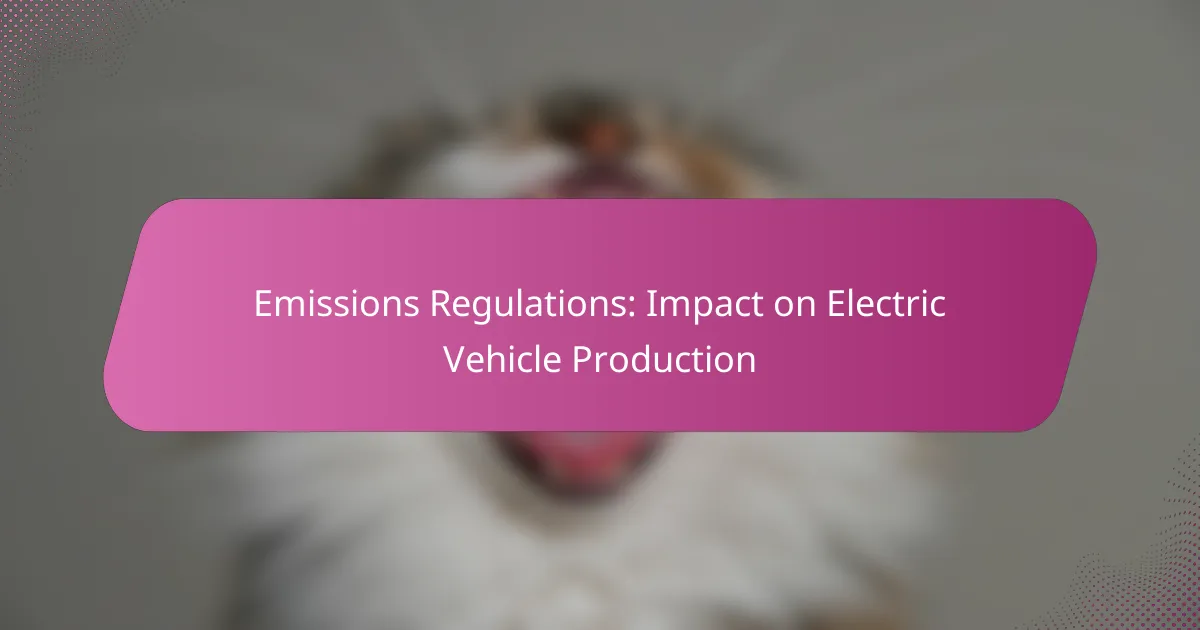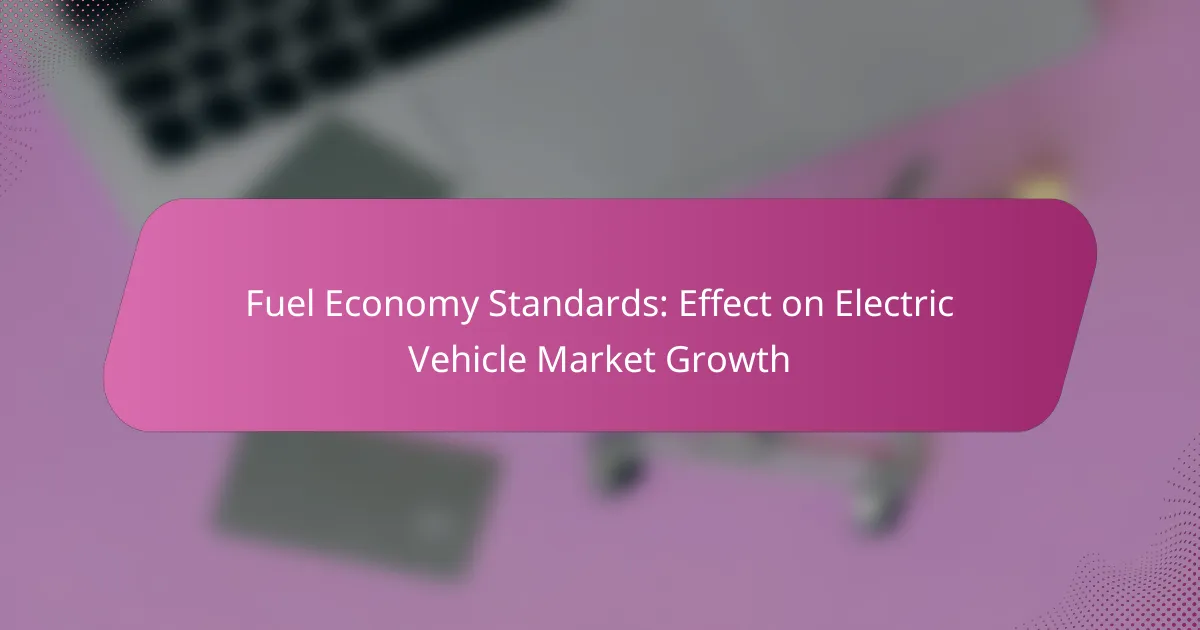Emissions regulations play a crucial role in shaping electric vehicle (EV) production by establishing standards that manufacturers must adhere to, influencing both costs and production strategies. These regulations not only drive innovation and investment in cleaner technologies but also promote the adoption of sustainable practices within the automotive industry, ultimately steering it towards a greener future.

How do emissions regulations affect electric vehicle production in the US?
Emissions regulations significantly influence electric vehicle (EV) production in the US by imposing standards that manufacturers must meet, which can increase costs and alter production strategies. These regulations drive innovation and investment in cleaner technologies, ultimately shaping the future of the automotive industry.
Increased compliance costs
Compliance with emissions regulations often results in increased costs for EV manufacturers. These costs can arise from the need to invest in new technologies, testing procedures, and certification processes to meet stringent environmental standards.
For instance, manufacturers may need to allocate substantial budgets for research and development to create vehicles that comply with evolving regulations. This can lead to higher prices for consumers, as companies may pass on some of these costs.
Shift in manufacturing processes
Emissions regulations necessitate a shift in manufacturing processes for electric vehicles. Manufacturers are increasingly adopting advanced production techniques that minimize emissions and enhance energy efficiency.
This shift may include the use of sustainable materials, implementing more efficient assembly lines, and integrating renewable energy sources into production facilities. Such changes can improve overall sustainability but may require significant upfront investment.
Impact on supply chain logistics
Emissions regulations also affect supply chain logistics for electric vehicle production. Manufacturers must ensure that their suppliers adhere to similar environmental standards, which can complicate sourcing and increase lead times.
For example, sourcing batteries and components from suppliers who meet emissions criteria can limit options and potentially raise costs. Manufacturers must strategically manage their supply chains to maintain compliance while optimizing efficiency and cost-effectiveness.
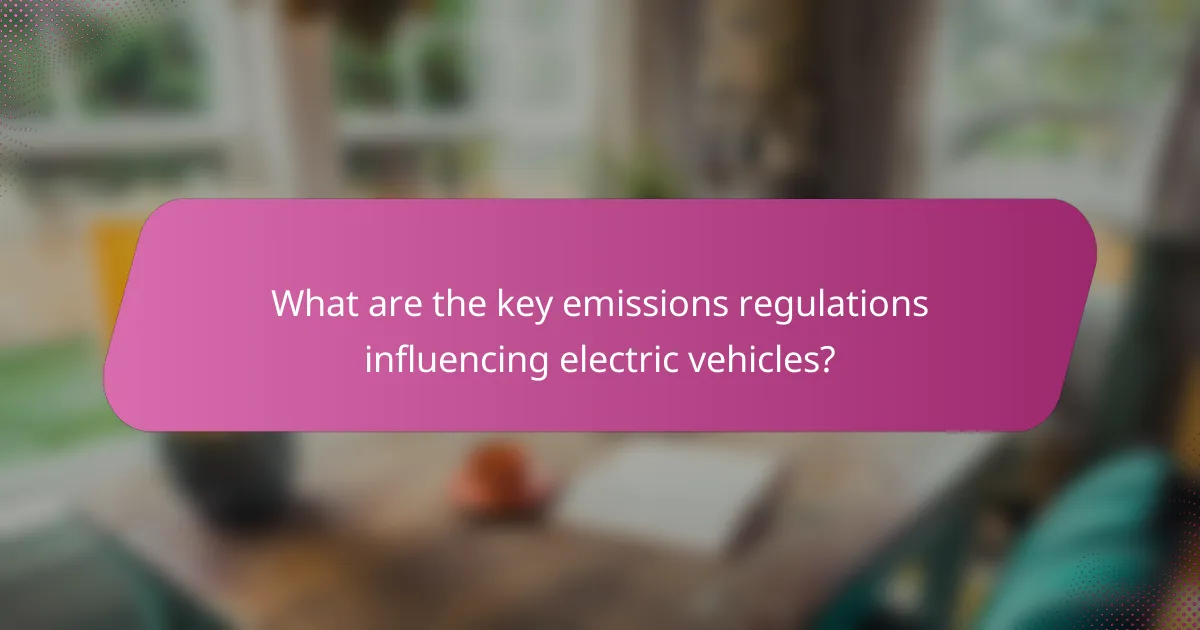
What are the key emissions regulations influencing electric vehicles?
Key emissions regulations significantly shape the production and adoption of electric vehicles (EVs). These regulations aim to reduce greenhouse gas emissions and promote cleaner transportation options, directly impacting manufacturers’ strategies and technologies.
California Air Resources Board (CARB) standards
The California Air Resources Board (CARB) sets stringent emissions standards that influence the automotive industry, particularly for electric vehicles. CARB mandates a specific percentage of zero-emission vehicles (ZEVs) in manufacturers’ fleets, pushing automakers to invest in EV technology to meet these requirements.
For instance, CARB’s ZEV program requires manufacturers to sell a certain number of electric vehicles based on their total sales in California. This creates a strong incentive for companies to prioritize EV production and innovation.
European Union CO2 emission targets
The European Union has established ambitious CO2 emission targets for vehicles, which directly affect electric vehicle production. These targets aim to reduce average emissions from new cars and vans significantly, pushing manufacturers to increase their electric vehicle offerings to comply.
As of recent regulations, the EU aims for a substantial reduction in emissions by 2030, with penalties for manufacturers that fail to meet these goals. This regulatory pressure encourages automakers to enhance their EV lineups and invest in sustainable technologies.
Corporate Average Fuel Economy (CAFE) standards
Corporate Average Fuel Economy (CAFE) standards set by the U.S. government require automakers to achieve a specific average fuel economy across their fleets. These standards are crucial for electric vehicle production as they incentivize manufacturers to produce more fuel-efficient and electric models to meet compliance.
Manufacturers that exceed CAFE standards can earn credits, which can be sold or traded, providing a financial incentive to invest in electric vehicle technology. This system encourages a shift towards cleaner vehicles, aligning with broader environmental goals.
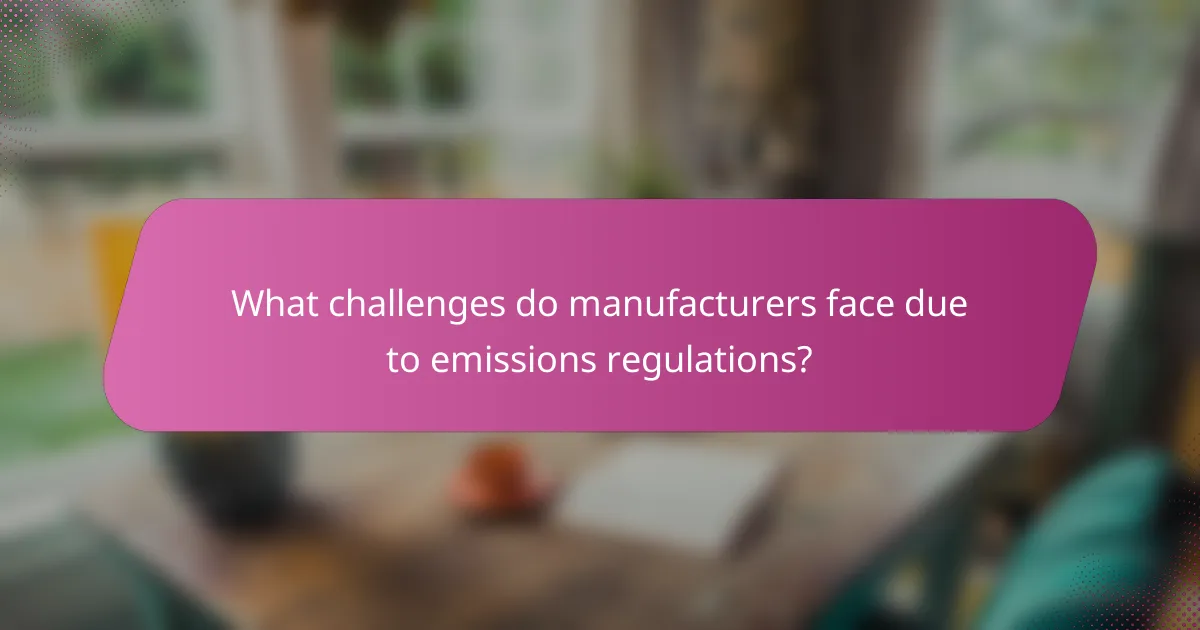
What challenges do manufacturers face due to emissions regulations?
Manufacturers encounter significant challenges from emissions regulations, which require them to adapt their production processes and technologies to meet stricter environmental standards. These regulations often lead to increased costs and necessitate a shift towards more sustainable practices in electric vehicle (EV) production.
Technological adaptation requirements
Manufacturers must invest in new technologies to comply with emissions regulations, which often involve complex engineering changes. This includes integrating advanced battery technologies and improving energy efficiency in electric vehicles. Adapting existing production lines to accommodate these technologies can be both time-consuming and costly.
Additionally, manufacturers need to ensure that their supply chains can support these technological changes, which may involve sourcing new materials or components that meet regulatory standards. This can create further logistical challenges and increase production timelines.
Investment in cleaner technologies
To meet emissions regulations, manufacturers are compelled to invest heavily in cleaner technologies, such as electric drivetrains and renewable energy sources for production. This investment can range from millions to billions of dollars, depending on the scale of production and the technologies being implemented.
While these investments can be daunting, they also present opportunities for manufacturers to innovate and differentiate their products in a competitive market. Companies that successfully adopt cleaner technologies may benefit from government incentives and a stronger brand reputation among environmentally conscious consumers.
Market competition pressures
The push for compliance with emissions regulations intensifies market competition, as manufacturers strive to produce more efficient and environmentally friendly vehicles. Companies that lag in adopting cleaner technologies risk losing market share to competitors who are quicker to innovate.
Furthermore, as consumer demand for electric vehicles rises, manufacturers face pressure to deliver products that not only meet regulatory standards but also offer superior performance and value. This dynamic can lead to a rapid evolution in vehicle design and features, requiring manufacturers to stay agile and responsive to market trends.
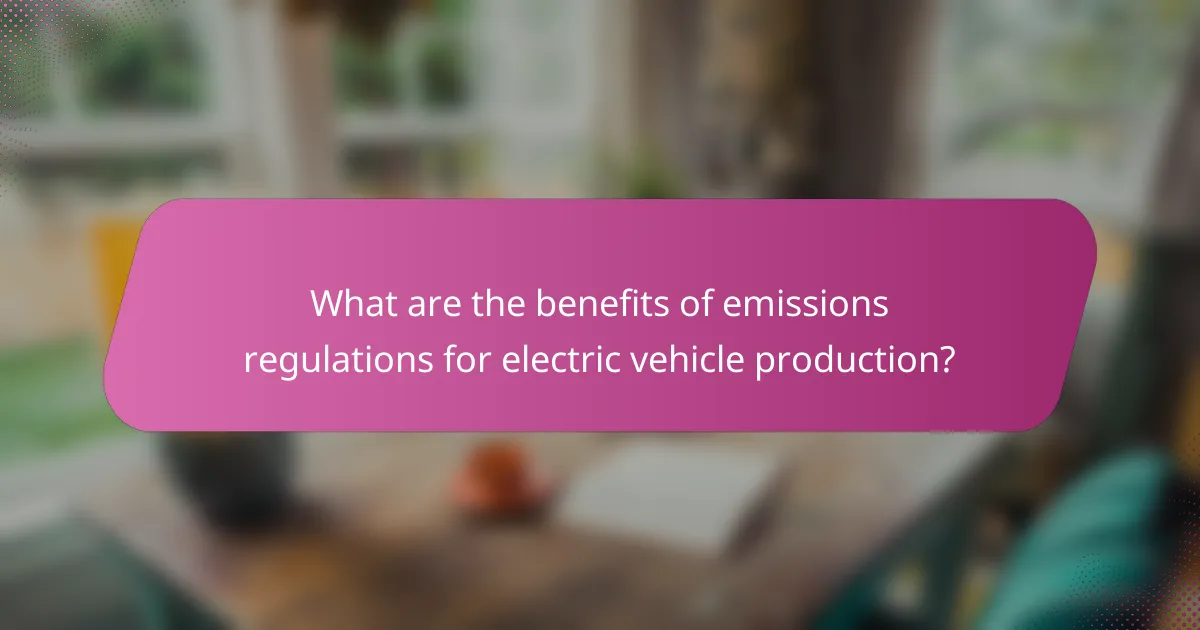
What are the benefits of emissions regulations for electric vehicle production?
Emissions regulations significantly benefit electric vehicle (EV) production by driving technological advancements, enhancing public health, and promoting long-term environmental sustainability. These regulations create a framework that encourages manufacturers to innovate and improve their offerings while addressing pressing health and ecological concerns.
Encouragement of innovation
Emissions regulations stimulate innovation in the electric vehicle industry by setting performance standards that manufacturers must meet. This often leads to the development of more efficient batteries, advanced materials, and improved vehicle designs. For instance, companies may invest in research and development to create lighter materials that enhance range and efficiency.
Moreover, these regulations can foster competition among manufacturers, pushing them to adopt cutting-edge technologies. As a result, consumers benefit from a wider range of EV options that are not only more efficient but also more affordable over time.
Improved public health outcomes
Stricter emissions regulations contribute to better public health by reducing air pollution associated with traditional combustion engines. Electric vehicles produce zero tailpipe emissions, which helps decrease harmful pollutants like nitrogen oxides and particulate matter in urban areas. This reduction can lead to lower rates of respiratory illnesses and other health issues linked to air quality.
Additionally, as more people transition to electric vehicles, communities can experience improved overall health outcomes, resulting in reduced healthcare costs. Healthier populations can lead to increased productivity and enhanced quality of life.
Long-term sustainability
Emissions regulations promote long-term sustainability by encouraging the shift from fossil fuels to renewable energy sources in the transportation sector. As electric vehicles become more prevalent, the demand for cleaner energy solutions increases, prompting investments in solar, wind, and other renewable technologies.
This shift not only helps mitigate climate change but also supports energy independence by reducing reliance on imported oil. By fostering a sustainable transportation ecosystem, emissions regulations can contribute to a healthier planet for future generations.
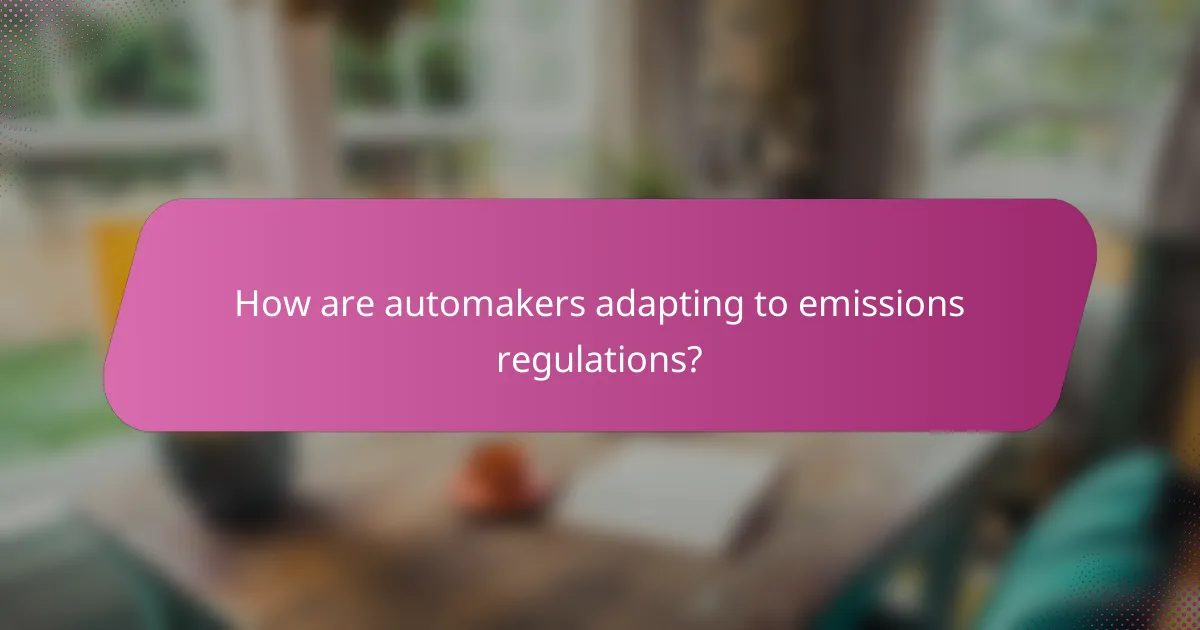
How are automakers adapting to emissions regulations?
Automakers are increasingly adapting to emissions regulations by investing in cleaner technologies and shifting their production focus towards electric vehicles (EVs). This transition is driven by both regulatory pressures and consumer demand for sustainable transportation options.
Investment in R&D for electric technologies
Automakers are significantly increasing their research and development (R&D) budgets to innovate electric technologies. This includes advancements in battery efficiency, charging infrastructure, and overall vehicle performance. Many companies are allocating billions of dollars annually to ensure they meet future emissions standards and consumer expectations.
For instance, major manufacturers like Volkswagen and Ford have committed to investing tens of billions in electric vehicle development over the next few years. This investment not only focuses on vehicle design but also on sustainable manufacturing processes to reduce overall carbon footprints.
Partnerships with battery manufacturers
To enhance their electric vehicle offerings, automakers are forming strategic partnerships with battery manufacturers. These collaborations aim to secure a stable supply of high-quality batteries, which are crucial for EV performance and range. By working together, companies can share technology and reduce production costs.
For example, Tesla has partnered with Panasonic to produce batteries at its Gigafactory, while General Motors has teamed up with LG Chem to develop next-generation battery cells. Such partnerships are essential for scaling production and meeting the increasing demand for electric vehicles.
Development of hybrid models
In addition to fully electric vehicles, automakers are focusing on the development of hybrid models as a transitional solution to meet emissions regulations. Hybrid vehicles combine traditional internal combustion engines with electric propulsion, offering improved fuel efficiency and reduced emissions compared to conventional vehicles.
Many manufacturers are introducing hybrids as a way to appeal to consumers who may not be ready to switch entirely to electric vehicles. For instance, Toyota’s Prius has been a market leader in hybrid technology, showcasing the potential for reduced emissions while maintaining driving range and convenience.

What role do government incentives play in electric vehicle production?
Government incentives significantly boost electric vehicle (EV) production by reducing costs for manufacturers and encouraging innovation. These incentives can take various forms, including tax credits and subsidies, which help make EVs more competitive in the automotive market.
Tax credits for manufacturers
Tax credits for manufacturers lower the effective tax burden, allowing companies to allocate more resources toward production and development. For instance, a manufacturer might receive a credit of several thousand dollars per vehicle produced, which can significantly enhance profitability.
These credits often depend on meeting specific production targets or using certain materials. Manufacturers should stay informed about eligibility criteria and potential changes in tax legislation to maximize their benefits.
Subsidies for research and development
Subsidies for research and development (R&D) provide financial support to companies working on innovative technologies in the EV sector. These funds can cover a range of activities, from battery technology improvements to advanced manufacturing processes.
For example, a government may offer millions of dollars in subsidies to a startup developing a new battery that promises longer range and lower costs. Companies should actively seek out available R&D subsidies and align their projects with government priorities to secure funding.
